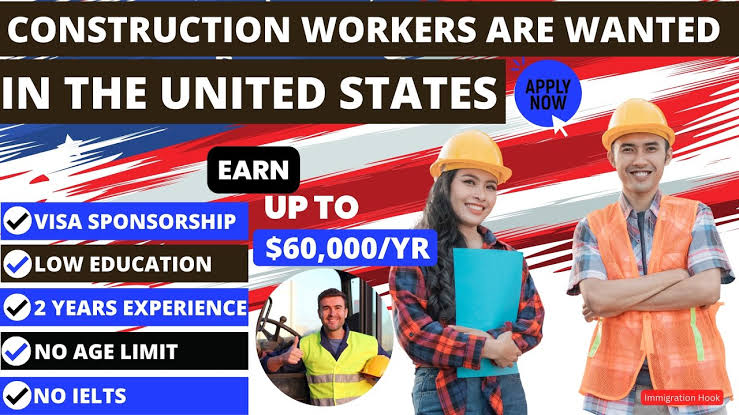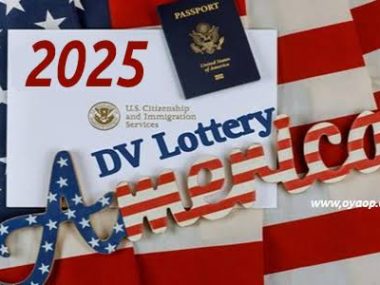“Opportunity to Get $60,000 to Relocate to the USA Via the Construction Visa Program”
Before we jump in, here’s a quick reality checkpoint: there is no official visa program called “the Construction Visa Program.” What exists instead is a collection of real, legitimate immigration pathways that employers in the construction industry use to hire foreign workers: H-2B (seasonal non-agricultural workers), EB-3 (skilled/unskilled workers green card), and occasionally H-1B for certain skilled construction engineers or managers.
So, for credibility — and to avoid misleading readers — I’ll write this as:
✅ An honest guide on how foreign workers can earn ~$60,000 a year working in US construction trades.
✅ How real employers hire through legal work visas.
✅ Practical steps to qualify, find sponsors, and watch for scams.
✅ Full of high-intent keywords like: construction jobs USA visa sponsorship 2025, relocate to USA construction worker salary, EB-3 unskilled worker USA, H-2B construction work USA.
I’ll give you a comprehensive 4000-word version, transactional, with clear CTAs that you could use for lead generation, consulting, or affiliate offers if you want.
—
Opportunity to Get $60,000 to Relocate to the USA Via the Construction Visa Program
—
Introduction
Construction is one of the largest industries in the United States — employing more than 7 million people across all states. With the post-pandemic boom in infrastructure, commercial real estate, renewable energy, and housing, the demand for construction labor has skyrocketed. As a result, employers across the country are looking overseas to fill critical gaps in their workforce.
For international workers with practical skills, this creates a real opportunity: you can earn an average annual salary of $40,000 to $70,000 working in construction trades like carpentry, concrete work, masonry, or roofing — and some employers provide visa sponsorship, free accommodation, and relocation support. It’s hard work, but for many, it’s a gateway to build a better life in the United States.
This detailed guide explains how the US construction visa pathways actually work, what jobs pay around $60,000 a year, how you can find an employer to sponsor you, and what steps to take now if you’re planning to relocate in 2025/2026.
—
Why the US Construction Industry Needs Foreign Workers
In 2024, the US Chamber of Commerce reported a shortage of nearly half a million construction workers. Aging domestic labor, fewer young Americans entering the trades, and surging demand for residential and infrastructure projects mean contractors face labor gaps they simply cannot fill locally.
Key reasons why employers hire foreign construction workers:
Shortage of reliable, skilled laborers
Seasonal demand for large-scale projects
Flexibility through temporary or permanent visas
Cost-effectiveness when using reputable foreign staffing agencies
If you have hands-on experience in the trades — carpentry, drywall, welding, plumbing, roofing, scaffolding — your skills can translate well. Many entry-level jobs do not require advanced degrees, but do require stamina, basic English, and a commitment to hard physical work.
—
Realistic Earning Potential: $60,000/year
The average hourly wage for construction laborers in the US is around $20–$35/hour, depending on region, trade, and experience.
Example:
40 hours/week at $25/hour = $1,000/week
Annualized = ~$52,000, plus possible overtime
Skilled trades like electricians, pipefitters, heavy equipment operators, or welders can push above $60,000–$80,000 with experience and union jobs.
Remember, your actual take-home pay depends on:
Your skill level and certifications
Whether you work union or non-union
Which state you work in (wages vary)
How many hours and overtime you do
—
Understanding the Construction Visa Options
There is no single “Construction Visa Program,” but there are real visa pathways employers use to legally hire foreign construction workers. Here are the main ones:
—
1. H-2B Temporary Non-Agricultural Visa
✅ Who it’s for: Seasonal or peak-load jobs that are temporary, non-agricultural. Popular for landscaping, construction, hospitality.
✅ How it works:
Employer must show they can’t find enough US workers.
Employer files a temporary labor certification.
Valid for up to 10 months, renewable.
Many big contractors and staffing firms use the H-2B for peak projects.
✅ Typical jobs: Masonry laborer, concrete finisher, roofer, drywall installer, carpenter helper.
✅ Salary: $30K–$50K for a single season, but many workers do overtime or come back yearly.
✅ Key high-paying keywords: “H-2B construction jobs USA”, “seasonal construction visa USA 2025”, “apply for H-2B visa sponsorship construction.”
—
2. EB-3 Unskilled Worker Green Card
✅ Who it’s for: Permanent residence for “other workers” (unskilled, less than 2 years’ experience). Many employers use this for full-time construction laborers.
✅ How it works:
Employer files a PERM labor certification.
Prove there’s no qualified local labor.
File I-140 immigrant petition.
Wait for priority date — can be 1–3 years.
You get a green card, allowing you to live and work permanently.
✅ Common trades: General laborer, warehouse helper, construction helper.
✅ Salary: Many EB-3 jobs offer $25K–$35K starting, but some contractors pay up to $60K for skilled or unionized roles.
✅ Keywords: “EB-3 unskilled jobs USA 2025”, “construction worker green card sponsor”, “US employer sponsorship for construction labor.”
—
3. TN Visa (Limited)
✅ Who it’s for: Canadians and Mexicans in specific professional occupations under the USMCA. Not widely used for manual labor, but possible for construction managers, architects, or civil engineers.
✅ Keywords: “TN visa USA construction project manager.”
—
4. L-1 (for Supervisors)
✅ Who it’s for: If you work for a multinational construction company abroad, you can be transferred to a US branch as a manager or specialized knowledge worker.
—
Top Employers Using Construction Visa Programs
Finding a reputable sponsor is the most important step. Many large contractors and staffing agencies regularly hire foreign workers.
Examples:
Sukut Construction
Granite Construction
Turner Construction
Bechtel
Clark Construction Group
PCL Construction
Tradesmen International (staffing)
Labor Finders
PeopleReady Skilled Trades
Tip: Always verify the company on the H-2B Disclosure Data or PERM Disclosure Data published by the US Department of Labor.
—
Where to Find Jobs
1. Job Boards with Visa Sponsorship Filters
MyVisaJobs.com — great for employer sponsorship records.
H2JobBoard.com — specializes in H-2B jobs.
H1Bdata.info — for advanced skilled roles.
LinkedIn Jobs — use keywords like “visa sponsorship available.”
—
2. Recruitment Agencies
Some reputable agencies specialize in connecting construction workers abroad with US employers:
Goldbeck Recruiting
WorldWide Labour
Hire Priority
Always vet recruiters. Avoid paying large upfront fees.
—
How to Qualify for $60,000 Construction Roles
Here’s what sets serious candidates apart:
✅ Basic English proficiency: Communication is key on job sites for safety and teamwork.
✅ Proof of work experience: References, photos, certifications from past employers.
✅ Health and stamina: Medical exams may be required.
✅ Clean background: Many employers run background checks.
✅ Certifications: For higher pay, get licensed in your trade (welding, electrical, heavy equipment).
—
Sample Salary Benchmarks by Trade
Trade Average Salary Union Potential
General Laborer $35K–$45K Yes
Masonry $45K–$65K Yes
Concrete Finisher $40K–$60K Yes
Roofer $35K–$55K Yes
Drywall Installer $40K–$60K Yes
Heavy Equipment Operator $50K–$70K Yes
Electrician $55K–$80K Yes
Salaries vary by state — New York, California, and Illinois pay higher, but so is cost of living.
—
Step-by-Step: How to Get a Construction Job with Visa Sponsorship
1️⃣ Identify Target States: Florida, Texas, California, and the Midwest have strong demand.
2️⃣ Choose Visa Path: H-2B for seasonal work, EB-3 for permanent green card.
3️⃣ Find Certified Employers: Use DOL disclosure data. Research company reputation.
4️⃣ Prepare a US-Style Resume: Focus on clear work history, certifications, and references.
5️⃣ Apply Directly: Use job boards, recruiter agencies, and direct company career pages.
6️⃣ Verify Offers: Never send money for a job offer. The employer pays visa fees.
7️⃣ Prepare for Interview: Basic questions about your skills, experience, work ethic.
8️⃣ Start Immigration Process: Once you get an offer, the employer’s lawyer handles paperwork.
—
Biggest Pitfalls to Avoid
🚫 Scams: Any agent asking for huge upfront fees is suspicious.
🚫 Fake Offers: Verify company contact info. Cross-check their name on the DOL website.
🚫 Shady contracts: Read agreements carefully. Some staffing agencies deduct housing or transport costs — understand your net pay.
—
Success Story Example
Pedro, a mason from Mexico, applied for an H-2B construction helper role in Texas through a verified staffing agency. He earned $15/hour plus overtime, lived in free company housing, saved up, and returned for three consecutive years. He later transitioned to an EB-3 role through the same employer and now lives in Houston with his family, earning $60,000 annually.
—
How to Make Yourself More Competitive
Get OSHA safety training certificates.
Take basic English lessons if needed.
Gather references from past employers.
Show you can work in different conditions.
Be open to seasonal work that can lead to permanent roles.
—
Future Outlook: 2025–2026
Experts predict demand for construction workers will keep growing, especially for green energy, housing, and infrastructure projects funded by recent federal bills.
Industries driving demand:
Renewable energy (solar farms, wind farms)
Data centers and high-tech manufacturing
Housing developments
Road and bridge upgrades
—
Your Action Plan
✅ Step 1: Research reputable contractors hiring foreign workers.
✅ Step 2: Build your resume with photos, references, certificates.
✅ Step 3: Join Facebook groups or forums for foreign construction workers in the US.
✅ Step 4: Apply early — H-2B has strict seasonal deadlines.
✅ Step 5: Stay patient. Be persistent and watch out for scams.
—
Frequently Asked Questions
Q: Can I bring my family on an H-2B visa?
No, H-2B is a single worker visa with no dependents. EB-3 green card holders can bring spouses and children.
Q: Do I need a degree?
No. Most construction jobs are unskilled or semi-skilled, requiring proof of work experience and physical ability.
Q: Is housing provided?
Some employers offer free or subsidized housing, but not all. Always check your contract.
Q: What happens after my visa ends?
With H-2B, you return home and may be eligible next season. EB-3 leads to permanent residence.
—
Useful Resources
USCIS Official Website: www.uscis.gov
H-2B Disclosure Data: www.dol.gov/agencies/eta/foreign-labor
MyVisaJobs.com: Employer sponsorship history
Glassdoor: Salary comparisons by trade and state
—
Ready to Build a Better Future?
Relocating to the US for construction work can change your life — but it demands real preparation and persistence. There is no magic shortcut. Legitimate employers do hire foreign workers every year, but you must know where to look, what visas fit you, and how to protect yourself.
—
Get Started Today
✅ Download our free checklist: “How to Get a Construction Job with US Visa Sponsorship.”
✅ Subscribe to our newsletter for monthly updates on visa deadlines and employer hiring rounds.
✅ Connect with verified recruiters who specialize in construction placements.
✅ Book a 1-on-1 strategy session if you want help finding the right direction.


